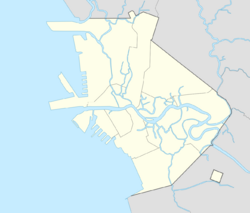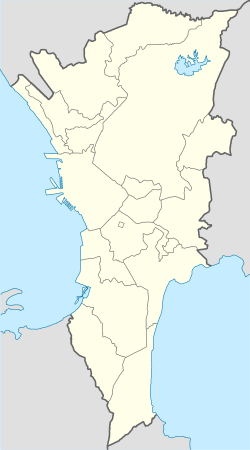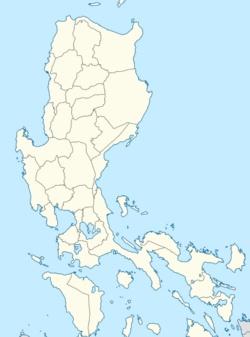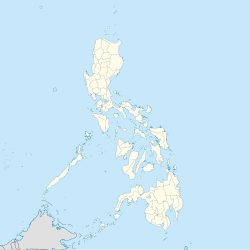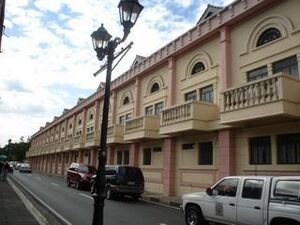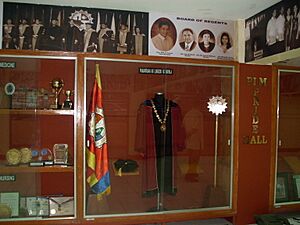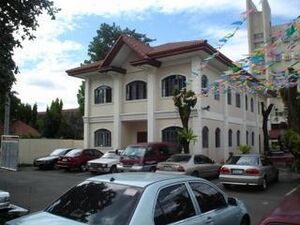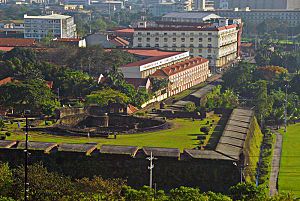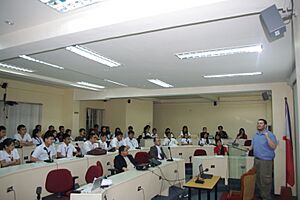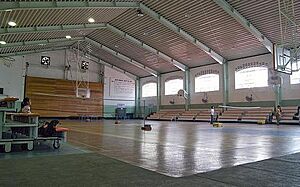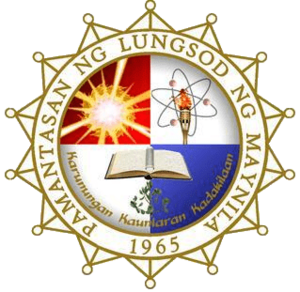Pamantasan ng Lungsod ng Maynila facts for kids
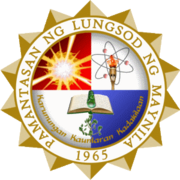 |
|||
| Motto | Karunungan, Kaunlaran, Kadakilaan | ||
|---|---|---|---|
|
Motto in English
|
Wisdom, Prosperity, Honor | ||
| Type | Public, Local university | ||
| Established | June 19, 1965 | ||
|
Academic affiliation
|
ASAIHL, IAU, ALCU | ||
| President | Domingo Reyes Jr. | ||
|
Academic staff
|
2,000 | ||
| Students | 13,000 | ||
| Undergraduates | 12,000 | ||
| Postgraduates | 1,000 | ||
| Location |
,
Metro Manila
,
Philippines
14°35′13″N 120°58′34″E / 14.587°N 120.976°E |
||
| Campus | Urban 30,000 square metres (3.0 ha) | ||
| Newspaper | Ang Pamantasan (The University) | ||
| Colors |
|
||
The Pamantasan ng Lungsod ng Maynila (PLM), also known as the University of the City of Manila, is a public university in Intramuros, Manila, Philippines. The city government of Manila provides its funding. The university started on June 19, 1965. It welcomed its first 556 students on July 17, 1967. These students were all from the top ten percent of graduates from Manila's public high schools.
PLM was the first university in the Philippines to offer free education. It was also the first university funded only by a city government. Plus, it was the first higher education school in the country to have its official name in Filipino.
From its first group of 556 students, the university has grown a lot. Now, about 10,000 students enroll each semester. PLM has expanded from one college to twelve colleges. It also has seven graduate schools and two professional schools. There are many research and special centers too, like a teaching hospital. A study from 1999 to 2003 showed that PLM was among the top five schools in the country for passing rates on important professional exams.
History
Where PLM is located
The land where PLM stands in Intramuros has a long history. It was once home to the Colegio de Manila, the first school in the Philippines. (This old school is not the PLM of today). Other buildings, like the first stone church in the Philippines, were also built here. Later, the buildings became a military headquarters called Cuartel del Rey. This is where José Rizal was put on trial in 1896.
During the American period, the area was a military base until 1941. It even hosted some of the first games for the NCAA. In World War II, General Douglas MacArthur had a command post here. However, the entire area was later destroyed during the war.
In the early 1960s, the city government rebuilt the site. A new building was constructed for Manila High School students. But on April 24, 1965, President Diosdado Macapagal gave the three-hectare lot to the new city university. Manila High School students moved to a new complex on February 26, 1967. Then, on July 17, 1967, the first PLM students began their studies.
How PLM was created
The idea for PLM started with Mayor Arsenio H. Lacson. In 1960, he approved a plan to set aside money for the university. After Mayor Lacson passed away, Vice Mayor Antonio de Jesus Villegas continued the plan.
In 1963, Villegas created a committee to plan the new city university. It was hard to get the city council to officially create the university. So, Villegas asked Congressman Justo Albert for help. A bill was passed by the House of Representatives in 1964. Senators Gil Puyat and Camilo Osías led the Senate's version of the bill.
On June 19, 1965, the final bill was signed into law by President Diosdado P. Macapagal. This law, called Republic Act No. 4196, is now the university's official charter.
The Board of Regents, which runs the university, was formed in the same year. Mayor Villegas appointed its members. The first Board members took office on January 9, 1967. They chose Benito F. Reyes as PLM's first president.
In 1967, PLM started with a college for an associate in arts degree. Later, it added graduate studies and other programs. President Reyes worked to expand PLM's courses. These included studies in arts, sciences, engineering, nursing, and government.
PLM in the 21st century
Growth and new programs

At the start of the 2000s, PLM began accepting students from outside Manila for the first time. Many changes were made, and the university continued to partner with other schools worldwide.
More money became available for new buildings and improvements on campus. Different departments and colleges were reorganized. The university also started new research groups.
In 2000, PLM launched its own printing press. It also opened a center for women's studies. From 2001 to 2003, the PLM Board of Regents added new courses. These included tourism, hotel management, and physical education. They also separated some large colleges into smaller, more focused ones.
In 2001, Mayor Lito Atienza allowed the opening of three district colleges under the city's university system. Around the same time, a learning center for young children started. A year later, PLM's Open University expanded its distance learning programs. It also partnered with schools in Saudi Arabia and Thailand. This allowed overseas Filipinos to continue their college education.
Student voice and English skills
In 2001, the Supreme Student Council (SSC), which is the student government, pushed for students to have a say on the PLM Board of Regents. In 2002, Senator Francis Pangilinan filed a bill to make this happen.
In July 2004, Mayor Lito Atienza started a program to improve English skills in all city-funded schools. The English as a Second Language (ESL) Center was set up at PLM. This program was first questioned by some, but later praised and copied by other schools.
Ongoing improvements
PLM continued to improve its facilities. This included fixing the gym and creating a faculty lounge. In 2007, the President Ramon Magsaysay Entrepreneurial Center was built. About two years later, two more buildings, Gusaling Intramuros and Bahay Maynila, were added.
Under the leadership of Adel Tamano, the university's libraries got more books. Tamano also made changes like stricter rules for student admission. He also worked to make sure that money matters were clear and honest.
Towards the end of Tamano's time as president, PLM created a better communication network on campus. This included improving the website and Wi-Fi access. The university also partnered with Smart Communications for a special SIM card and information system for students. It also worked with Microsoft for official PLM email addresses and online learning tools.
Future plans
The PLM Administration has plans to build a city university system that would cover all parts of Manila. They also want to turn the main campus in Intramuros into a center for advanced studies and research. This would include a science and technology institute.
How PLM works
Academics and leadership
PLM is an independent university. It is run by a Board of Regents and led by a president. The Board of Regents makes the most important decisions for PLM. They approve diplomas and certificates for students. The Board has six members, including the PLM president. Each member serves for six years. The president makes sure the university's plans are carried out.
Right below the president are four vice presidents. They handle academics, administration, and finances.
| The Presidents of the Pamantasan ng Lungsod ng Maynila University of the City of Manila |
| Benito F. Reyes, February 23, 1967 – June 23, 1972 |
| Consuelo L. Blanco, December 21, 1972 – May 31, 1978 |
| Ramon D. Bagatsing, June 1, 1978 – October 27, 1982 |
| Jose D. Villanueva, January 14, 1983 – June 30, 1989 |
| Benjamin Tayabas, July 1, 1989 – June 24, 1996 |
| Virsely dela Cruz, June 25, 1996 – April 30, 1999 |
| Ma. Corazon T. Veridiano (Acting President), May 1999 - December 1999 |
| Atty. Emmanuel R. Sison (Officer-in-Charge), December 1999 - February 2000 |
| Benjamin Tayabas, February 24, 2000 – August 1, 2007 |
| Jose M. Roy III, (Acting President) February 23, 2006 – May 31, 2006 |
| Atty. Adel A. Tamano, August 4, 2007 – November 30, 2009 |
| Rafaelito M. Garayblas (Officer-in-Charge), December 1, 2009– June 30, 2013 |
| Artemio G. Tuquero, July 1, 2013–September 2014 |
| Ma. Leonora V. de Jesus, September 2014 – July 2019 |
| Emmanuel A. Leyco, July 2019 – 2024 |
| Domingo Reyes, Jr., July 2024 – Present |
The university has 12 undergraduate colleges and two professional schools. It also has seven graduate schools and a distance learning program. These units offer many different degree programs.
PLM is one of the largest universities in Metro Manila. In 2006, it had over 13,700 students. For the 2006–2007 school year, PLM received 40,000 applications but accepted only 3% of them. Students who live in Manila can get full scholarships. Other scholarships are also available from alumni, the government, and private groups.
PLM uses a semester system for its courses. It also uses a grading scale from 1.00 to 5.00, where 1.00 is the highest grade.
Helping the community
PLM students are involved in many community projects. Medical students spend months in distant villages to gain experience. Nursing students work in city health centers. Senior nursing students live in rural areas for eight weeks to help with health projects.
Physical therapy students apply their skills in rehabilitation centers. Students from the College of Human Development visit communities in Manila. They help teach preschoolers and tutor children who are not in school. Other colleges also have outreach programs and on-the-job training.
In 2009, PLM started the Alternative Learning Program (ALP). This program offers a different way to learn, using non-formal and informal methods.
The PLM community also joins groups like Caritas Manila for dental and medical missions. They have also organized blood donation drives for hospitals in Manila. These efforts help many patients in need.
Research and new ideas
PLM conducts studies and research projects. These projects help in making policies and creating new products. PLM is part of a group of academic institutions that work with the Department of Science and Technology. It is also a member of the CHED Zonal Research Program for the National Capital Region.
Reputation
Rankings
There are no fixed ways to rank universities in the Philippines. However, schools are often compared based on their performance in professional exams. The Professional Regulation Commission (PRC) and the Commission on Higher Education (CHED) sometimes publish these results.
A study from 1994 to 1998 showed PLM was ranked sixth. From 1992 to 2001, it was ninth. In a study covering 1999 to 2003, PLM was ranked fifth. This made it one of the top public universities. As of 2021, no new official rankings have been released.
Campus
The PLM campus is located in Manila's historic Intramuros district. It covers about 3 hectares (7.4 acres). The campus has an open field with the PLM Grandstand.
Most buildings on campus have a 19th-century or Spanish-style design. They feature details like those found in old Filipino houses called bahay na bato. The buildings are either separate or connected to each other.
The university has many facilities for learning and recreation. These include an amphitheater, audiovisual rooms, and an auditorium. There is campus-wide Wi-Fi and free internet stations. Other facilities include a gym, a learning center for young children, libraries, and a health service unit. There are also science, communications, and engineering laboratories.
Student life
PLM students have many activities outside of class. The university offers sports, cultural shows, and over 50 student groups. There are religious groups like LifeBox-PLM and Youth for Christ. Engineering teams, like the Microcontrollers and Robotics Society, have won national awards. Debate teams, such as the Speech and Debate Society, are also active. Many groups focus on community service, like the PLM Samaritans.
The Office of Student Development and Services (OSDS) helps coordinate student programs. The President's Committee on Arts and Culture (PCAC) supports student artists. This includes groups like the Hiyas ng Maynilad Dance Troupe and the PLM Chorale. Marulaya is the university's first theater arts group.
The PLM Activity Center hosts many events. The university invites notable speakers each year. These often include scholars, politicians, and authors. Different groups also hold discussions on various topics.
Concerts and shows are often held at the PLM Grandstand. In 2008, the campus hosted Opusfest, an international music festival. PLM also participated in the Ship for Southeast Asian Youth Program (SSYEAP). This program promotes friendship among young people from Southeast Asia and Japan.
The student government at PLM is the Supreme Student Council (SSC). It is led by a student president. There are also student councils for each college. Students have two main political parties that take part in elections. A long-term goal for student leaders is to have a student representative on the Board of Regents.
Ang Pamantasan is PLM's official student publication. It started in 1979. The publication works to protect campus press freedom. There are also other publications and academic journals at PLM.
The PLM community takes part in inter-university games and sports events. They also join the Manila Youth Games and the Alculympics. This is a sports organization for 18 local colleges and universities.
In 2019, the PLM Supreme Student Council spoke out against attacks on press freedom. In response, the university administration set rules that limited students from discussing national issues. Students protested these rules.
In October 2022, PLM changed its uniform policy. It removed gender-based rules, allowing students more choices. This showed the university supports academic freedom and gender expression.
Symbols
Motto and hymn
PLM's motto is "Karunungan, Kaunlaran, Kadakilaan". This Filipino motto means "Knowledge, Progress, Greatness". These are the guiding ideas for the university. The official hymn is called "Pamantasang Mahal", which means "Beloved University".
Seal
The University Seal was designed by Arch. Carlos da Silva. The Board of Regents officially accepted the seal on June 17, 1967.
The seal is a circular shield with fourteen triangles around it, like sunbeams. It has "Pamantasan ng Lungsod ng Maynila 1965" written in gold. The inside of the shield is divided into four parts. It shows a sunburst, a flaming torch, and a book with ancient Tagala script. There is also a branch of the Nilad shrub. The motto "Karunungan, Kaunlaran, Kadakilaan" is written at the bottom. The four parts of the shield represent the four congressional districts of Manila at that time. The fourteen triangles stand for the administrative districts of Manila.
Colors
The university colors are golden yellow, flaming red, light blue, and green. Golden yellow means nobility and wealth. White means light, truth, and faith. Light blue means brotherly love and peace. Red means patriotism and bravery. Green means hope.
Alumni
PLM has about 50,000 alumni since it opened in 1967. Alumni work in many different jobs around the world. PLM students and graduates are called PLMayers.
Many notable alumni have worked in the Philippine government. These include Senator Ping Lacson and former Manila Mayor Lito Atienza.
In writing and journalism, PLM has produced winners of the Palanca Awards, like Manuel Buising. Other authors and media people include award-winning screenwriters and directors.
In entertainment and television, PLM alumni include comedian Michael V. and singer Aicelle Santos.
PLM alumni also hold important positions in companies. These include Wilma Galvante from GMA Network and Rolando G. Peña from Smart Communications.
In education and research, PLM alumni include business expert Conrado E. Iñigo, Jr. and nurse-educator Carlito Balita.
Images for kids
See also
 In Spanish: Universidad de la Ciudad de Manila para niños
In Spanish: Universidad de la Ciudad de Manila para niños
- List of Pamantasan ng Lungsod ng Maynila faculty
- Universidad de Manila, the other city university of Manila
- University of the Philippines Manila, the component university of the University of the Philippines system in Manila
- University of Manila, a private university in Manila


